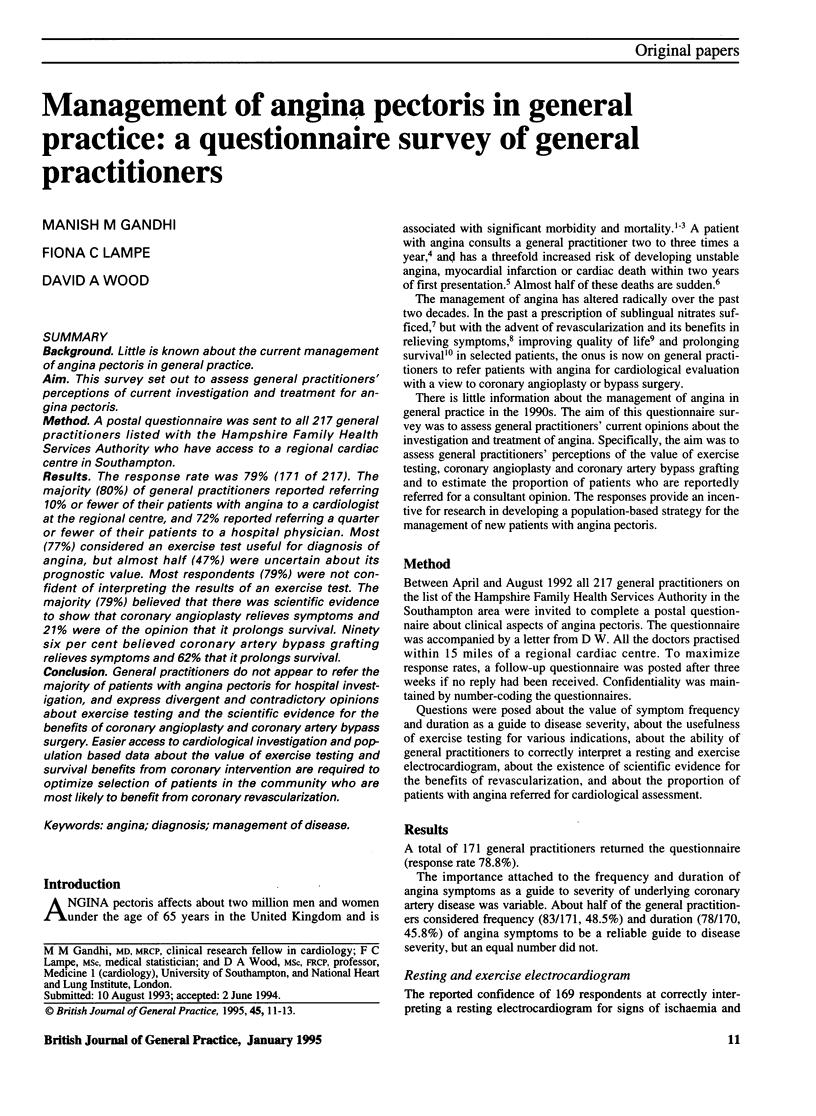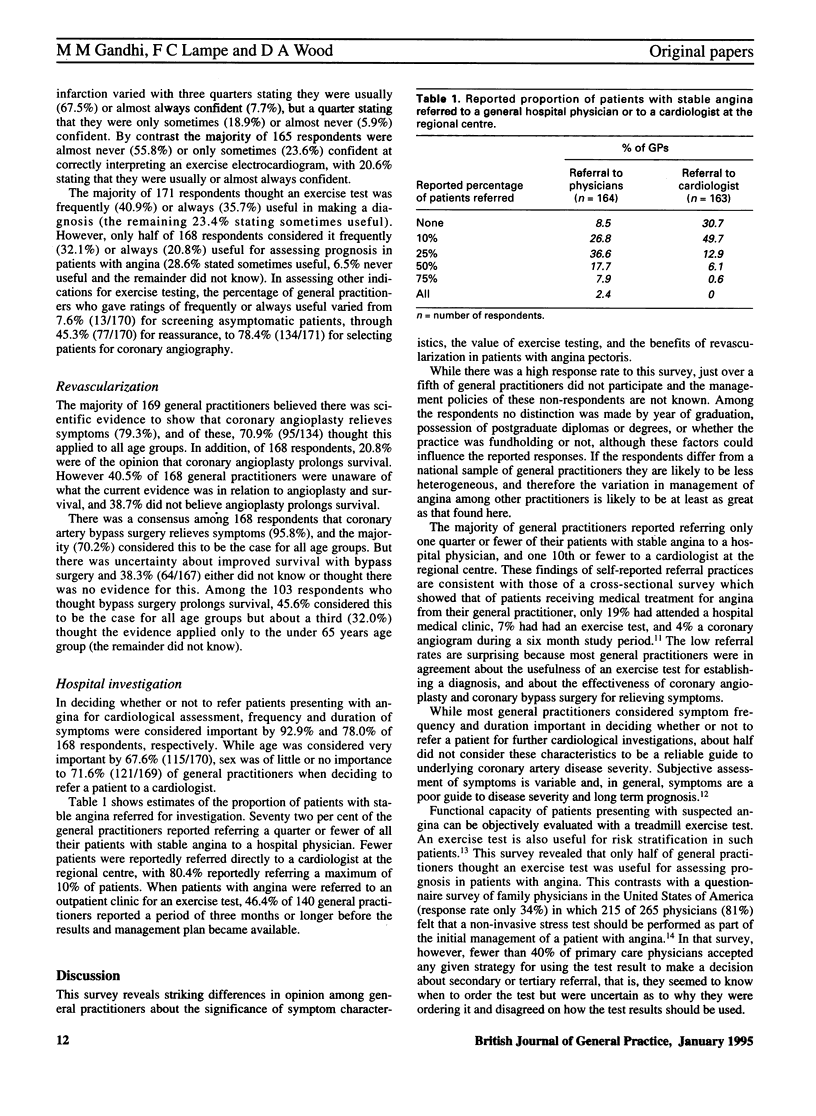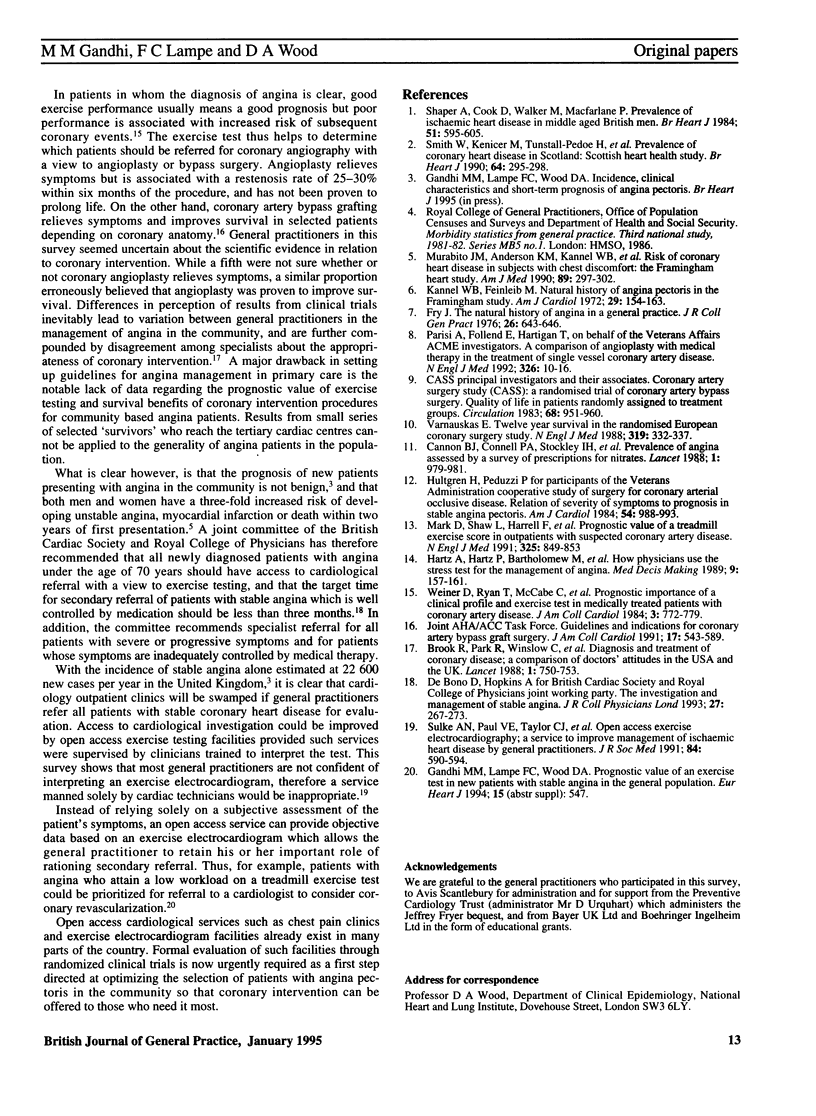Abstract
BACKGROUND. Little is known about the current management of angina pectoris in general practice. AIM. This survey set out to assess general practitioners' perceptions of current investigation and treatment for angina pectoris. METHOD. A postal questionnaire was sent to all 217 general practitioners listed with the Hampshire Family Health Services Authority who have access to a regional cardiac centre in Southampton. RESULTS. The response rate was 79% (171 of 217). The majority (80%) of general practitioners reported referring 10% or fewer of their patients with angina to a cardiologist at the regional centre, and 72% reported referring a quarter or fewer of their patients to a hospital physician. Most (77%) considered an exercise test useful for diagnosis of angina, but almost half (47%) were uncertain about its prognostic value. Most respondents (79%) were not confident of interpreting the results of an exercise test. The majority (79%) believed that there was scientific evidence to show that coronary angioplasty relieves symptoms and 21% were of the opinion that it prolongs survival. Ninety six per cent believed coronary artery bypass grafting relieves symptoms and 62% that it prolongs survival. CONCLUSION. General practitioners do not appear to refer the majority of patients with angina pectoris for hospital investigation, and express divergent and contradictory opinions about exercise testing and the scientific evidence for the benefits of coronary angioplasty and coronary artery bypass surgery. Easier access to cardiological investigation and population based data about the value of exercise testing and survival benefits from coronary intervention are required to optimize selection of patients in the community who are most likely to benefit from coronary revascularization.
Full text
PDF


Selected References
These references are in PubMed. This may not be the complete list of references from this article.
- Brook R. H., Kosecoff J. B., Park R. E., Chassin M. R., Winslow C. M., Hampton J. R. Diagnosis and treatment of coronary disease: comparison of doctors' attitudes in the USA and the UK. Lancet. 1988 Apr 2;1(8588):750–753. doi: 10.1016/s0140-6736(88)91550-4. [DOI] [PubMed] [Google Scholar]
- Fry J. The natural history of angina in a general practice. J R Coll Gen Pract. 1976 Sep;26(170):643–646. [PMC free article] [PubMed] [Google Scholar]
- Hartz A., Houts P., Bartholomew M., Goldman S., Kantner T., Deber R. How physicians use the stress test for the management of angina. Med Decis Making. 1989 Jul-Sep;9(3):157–161. doi: 10.1177/0272989X8900900302. [DOI] [PubMed] [Google Scholar]
- Kannel W. B., Feinleib M. Natural history of angina pectoris in the Framingham study. Prognosis and survival. Am J Cardiol. 1972 Feb;29(2):154–163. doi: 10.1016/0002-9149(72)90624-8. [DOI] [PubMed] [Google Scholar]
- Kurz R. W., Ren X. L., Franz M. R. Dispersion and delay of electrical restitution in the globally ischaemic heart. Eur Heart J. 1994 Apr;15(4):547–554. doi: 10.1093/oxfordjournals.eurheartj.a060541. [DOI] [PubMed] [Google Scholar]
- Mark D. B., Shaw L., Harrell F. E., Jr, Hlatky M. A., Lee K. L., Bengtson J. R., McCants C. B., Califf R. M., Pryor D. B. Prognostic value of a treadmill exercise score in outpatients with suspected coronary artery disease. N Engl J Med. 1991 Sep 19;325(12):849–853. doi: 10.1056/NEJM199109193251204. [DOI] [PubMed] [Google Scholar]
- Murabito J. M., Anderson K. M., Kannel W. B., Evans J. C., Levy D. Risk of coronary heart disease in subjects with chest discomfort: the Framingham Heart Study. Am J Med. 1990 Sep;89(3):297–302. doi: 10.1016/0002-9343(90)90341-a. [DOI] [PubMed] [Google Scholar]
- Parisi A. F., Folland E. D., Hartigan P. A comparison of angioplasty with medical therapy in the treatment of single-vessel coronary artery disease. Veterans Affairs ACME Investigators. N Engl J Med. 1992 Jan 2;326(1):10–16. doi: 10.1056/NEJM199201023260102. [DOI] [PubMed] [Google Scholar]
- Shaper A. G., Cook D. G., Walker M., Macfarlane P. W. Prevalence of ischaemic heart disease in middle aged British men. Br Heart J. 1984 Jun;51(6):595–605. doi: 10.1136/hrt.51.6.595. [DOI] [PMC free article] [PubMed] [Google Scholar]
- Smith W. C., Kenicer M. B., Tunstall-Pedoe H., Clark E. C., Crombie I. K. Prevalence of coronary heart disease in Scotland: Scottish Heart Health Study. Br Heart J. 1990 Nov;64(5):295–298. doi: 10.1136/hrt.64.5.295. [DOI] [PMC free article] [PubMed] [Google Scholar]
- Sulke A. N., Paul V. E., Taylor C. J., Roberts R. H., Norris A. D. Open access exercise electrocardiography: a service to improve management of ischaemic heart disease by general practitioners. J R Soc Med. 1991 Oct;84(10):590–594. doi: 10.1177/014107689108401007. [DOI] [PMC free article] [PubMed] [Google Scholar]
- Varnauskas E. Twelve-year follow-up of survival in the randomized European Coronary Surgery Study. N Engl J Med. 1988 Aug 11;319(6):332–337. doi: 10.1056/NEJM198808113190603. [DOI] [PubMed] [Google Scholar]
- Weiner D. A., Ryan T. J., McCabe C. H., Chaitman B. R., Sheffield L. T., Ferguson J. C., Fisher L. D., Tristani F. Prognostic importance of a clinical profile and exercise test in medically treated patients with coronary artery disease. J Am Coll Cardiol. 1984 Mar;3(3):772–779. doi: 10.1016/s0735-1097(84)80254-5. [DOI] [PubMed] [Google Scholar]


